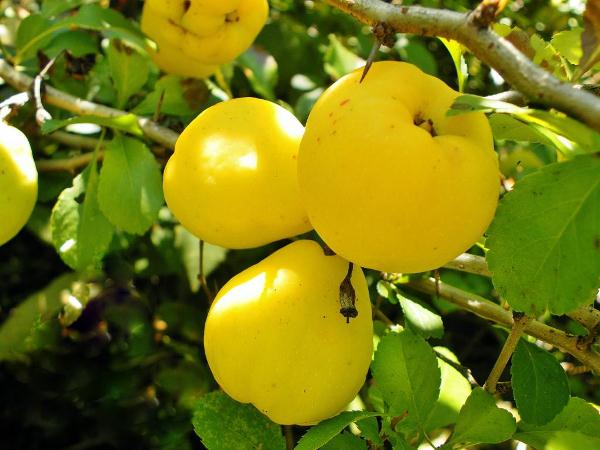What is Quince? This is a significant fruit culture for humans. Fragrant fruits are used for culinary preparations, carved products are made of wood, and in fruit-growing the plant is used as a stock for many crops.. However, few people know about the therapeutic and beneficial properties of the quince, which possess almost all parts of the plant. Let's talk more about the benefits that bring the fruits of this plant for the human body.
Table of contents
General characteristics of Quince culture
Quince ordinary - deciduous tree or shrub, the only representative of its kind. This is one of the ancient cultivated crops, whose history goes back 4000 years. The homeland of the plant is considered the country of the Caucasus and Central Asia.here it is found in the wild now. But culture received its first glory in ancient Greece. Here she was given the name that is used in biology and now - “Cydonia”.
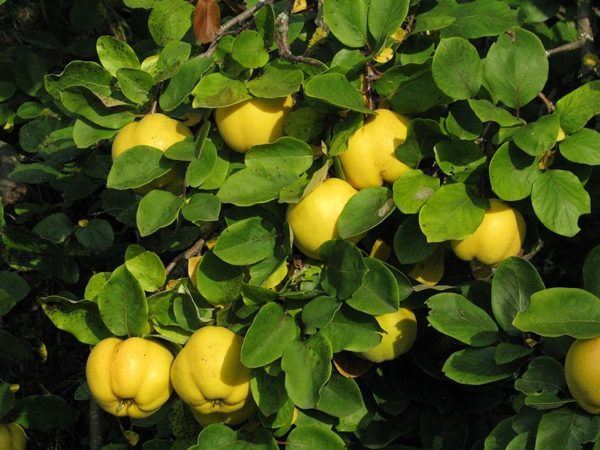
The books of Pliny (77 AD) "Natural History" and the Armenian scholar Amirdovlat Amasiatsi (XVth century) "Unnecessary for ignoramuses" helped restore the history of culture and its use by different nations. They describe in detail the healing, restorative and restorative properties of quince fruits. Today, these data are confirmed by biochemical studies.
Today we know more 400 varieties quince. They differ only in the insignificant structure of flowers and the shape of fruits that look like a pear. The fruits of the yellow color culture, in some cases with a one-sided red tint, are dense, tough and crunchy with a slight pubescence.Depending on the variety, they can be round or pear-shaped, reach up to 2 kg weights. The fruits ripen in September-October.
The pulp of the fruit is viscous and tart. The aroma resembles an apple with a subtle coniferous shade. In the fruit of quince is from 50 before 70 brown seedsthat have valuable healing properties.
Fruits are rarely eaten fresh. They are valuable as a raw material for the canning industry and home cooking. Thanks to the persistent aroma and extraordinary taste, they make good jams, jams, jellies, candied fruits and marmalades. In winemaking, the fruit is used to prepare a special brand of wine, and in medicine it is used for flavoring rooms (aromatherapy). Quince firmly entered the cooking of the Central Asian republics, Georgia, Azerbaijan and Armenia.
Useful properties and composition of Quince fruits
With the emergence of other cultures that have a more attractive flavor, the use of quince unfairly pushed aside. but Quince fruits can be called a real natural pharmacy, therapeutic and beneficial properties, which confirms the biochemical analysis.
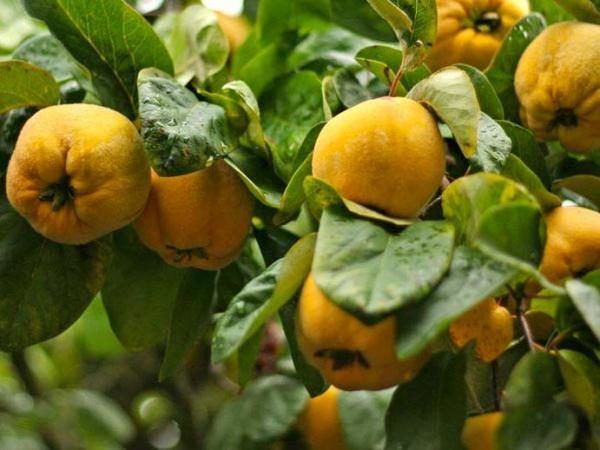
100 g of the product contains:
- carbohydrate 9.6 g;
- dietary fiber 3.6 g;
- proteins 0.6 g;
- fat 0.5 g;
- organic acids 0.9 g;
- water 84 g;
- ash 0.8 g
The energy value 48 kcal.
The absence of cholesterol, low fat content and a significant amount of dietary fiber make quince fruits a dietary product. Therefore, they will be useful for obesity or low-calorie diet. Regular use of the product normalizes the intestinal flora, promotes the elimination of toxins in a natural way..
Pectins (3%) of the fruit, getting into the stomach, form a gel-like substance, enveloping the intestinal mucosa. It becomes a reliable protection from irritation.
Quince fruits contain organic acids, tannins. Essential oils are concentrated in the skin.
Macronutrients (100g):
- potassium 144 mg;
- phosphorus 24 mg;
- calcium 23 mg;
- magnesium 14 mg;
- sodium 14 mg.
Iron is also found in fruits. 3 mg.
Potassium dominates in the mineral composition of fruits. It is the main regulator of the acid-base balance of blood, the level of intercellular and cellular fluid, osmotic pressure. These properties of the mineral are valuable in pathologies, accompanied with an increase in the level of fluid in the body.
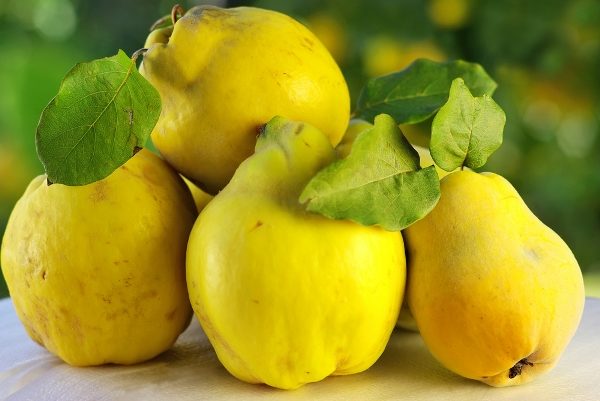
Phosphorus and calcium, essential components of the bone structure, are important for strengthening the skeleton and teeth.. Phosphorus is a carrier of transformed energy in all cells of the body, which provide muscle contraction and brain activity. Magnesium inhibits nervous excitability and regulates the functions of the respiratory center.
Quince is a good source of iron. This is the main component of hemoglobin and myoglobin, oxygen carriers in all cells of the body. When their synthesis is disturbed, anemia develops in the body, which gradually leads to hypoxia (oxygen starvation). Especially susceptible to iron deficiency anemia, children, pregnant women and the elderly.Iron is an important element for the functioning of the thyroid gland.
Vitamins (100 g):
- ascorbic acid (C) 23 mg;
- tocopherol (E) 0.4 mg;
- nicotinic acid (PP) 0.3 mg;
- riboflavin (B2) 0.04 mg;
- thiamine (B1) 0.02 mg.
The color of the fruit betrays beta-carotene (0.4 mg), which in the body is converted to vitamin A (167 mcg). A significant amount of vitamin C in the fruit helps to fight colds., increases the protective functions of the body. Beta-carotene is the strongest antioxidant, contributes to the removal of toxins from the body.
Possible harm and contraindications to the use of fruit
With all the positive qualities of this fetus, there are contraindications. The pulp of the quince fruit has an astringent and anchoring effect. Therefore they contraindicated in constipation and intestinal obstruction. Organic acids of the fruit can complicate the course of acute gastritis and ulcerative diseases of the gastrointestinal tract. Acids are also harmful to the tooth enamel, so after each use of the fruit is recommended to rinse the mouth.
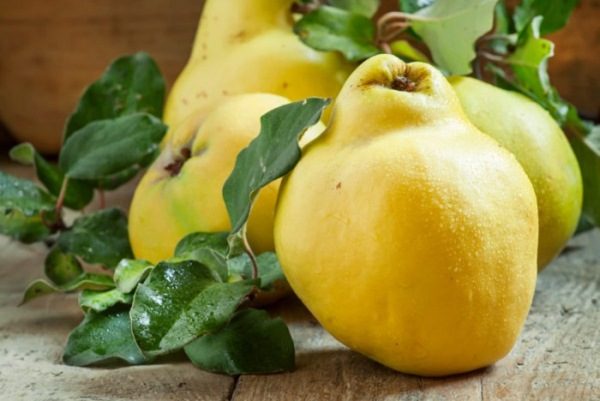
Felt that covered quince fruits can damage the vocal cords or cause irritation of the upper respiratory tract. This should be taken into account by people whose professions are associated with public speaking (singers, lecturers). They are recommended to use the fruit in peeled form.
Quince fruits are potential allergens, so they should not be consumed if the body is hypersensitive. Enter the product in baby food is possible only at one-year age in a purified form..
The use of leaves, seeds and quince pulp in traditional medicine
In folk medicine, different parts of the plant are used for the treatment and prevention of many pathologies.
Special attention in folk medicine is given to quince seeds. Their shells consist of water-soluble mucus. (22 %), tannins and minerals. After infusion of seeds in water, a gel-like mass is formed, which has an enveloping, antispasmodic, anti-inflammatory, emollient and hemostatic effect.
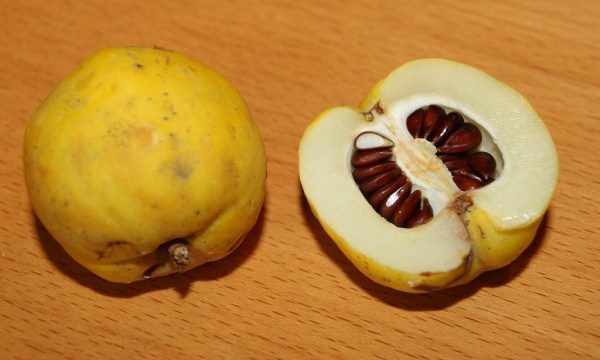
These properties of seeds are used to treat:
- dysentery;
- bronchopulmonary diseases;
- internal bleeding;
- GI pathology;
- viral and bacterial infections
- hemorrhoids;
- blepharitis;
- dermatitis, skin irritations, burns;
- inflammation of the oral cavity.
Quince fruits have cardioprotective, antiemetic, astringent, anti-inflammatory, antiseptic and diuretic properties. Therefore, they are used to treat:
- hypertension, atherosclerosis, cardiac abnormalities;
- diseases of the urinary system;
- catarrhal diseases;
- toxin poisoning;
- anemia.
The leaves and flowers of quince are used to treat diabetes, hypertension and hyperhidrosis (excessive sweating). Used as a diuretic for cardiac and pulmonary edema.
The best folk recipes
Despite the relative safety of folk remedies from quinces, they can harm people with chronic or acute pathologies. Therefore, before applying it is important to consult a doctor.
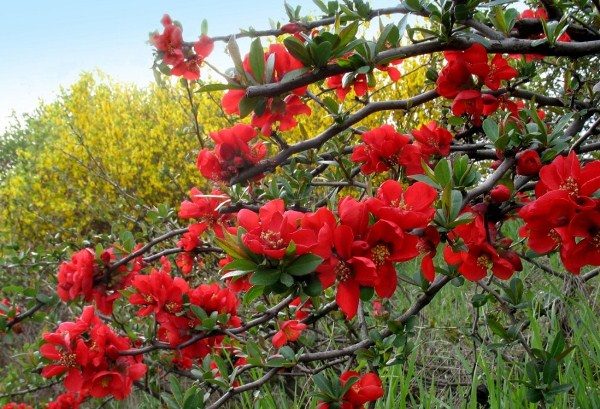
Recipes and treatments:
- Sore throat, cough. The average fruit of the quince is cut into pieces and poured boiling water (250 ml), insist 30 minutes. Take 1 tbsp. l 4 times a day.
- Hypertension, swelling. The sliced fruits of quince (2 pieces) are poured with water (0.5 l), boiled over low heat for 10 minutes and infused for 1 hour. Take 100 ml 3 times a day, separately from meals.
- Asthma. Crushed dry leaves (1 tsp) are poured with boiling water (250 ml) and steamed in a water bath for 15 minutes. The broth is cooled, filtered and brought to a volume of 250 ml with boiled water. Take 50 ml 3 times a day 30 minutes before meals.
- Hyperhidrosis. Crushed leaves (1 tablespoon) are poured with boiling water (250 ml), boiled for 10 minutes and infused for 1 hour. Used for wiping the skin.
- Colitis, gastroenteritis. Seeds of quince (10 g) pour cold water (1 l), insist 1 hour. Strained infusion take 100 ml 4 times a day. This remedy is also used to treat inflammation of the gums. To do this, extract the mouth 4 times a day.
- Burns, dermatitis. In these cases, an infusion of seeds. For this purpose, gauze fabric moistened with a medium is applied to problem areas for 30 minutes. Infusion also wipe eyes inflamed with blepharitis.
- Dysbacteriosis (diarrhea). Dried fruit partitions (1 tbsp. L.) Are brewed in boiling water (250 ml), insisted in a thermos for 3 hours. Take 2 tbsp. l 4 times a day.
- Anemia. The sliced quince fruits are poured with water until the surface is completely covered and boiled until softened. After that, squeeze the juice and boil over low heat until it acquires a thick consistency. Take 1 tbsp. l 3-5 times a day.
- Uterine bleeding. Seeds (10 pcs.) Pour boiling water (200 ml), bring to a boil and incubate for 3 minutes. The filtered agent is taken in 100 ml 3 times a day.
- Diabetes. Crushed leaves (2 tablespoons) are poured with water (250 ml) and boiled for 15 minutes over low heat. Cooled and filtered decoction take 1 tbsp. l 3 times a day.
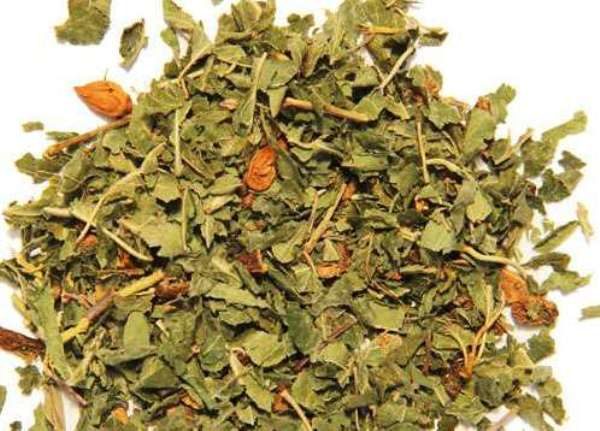
If you add potato starch to the mucus quince, thereby increasing the thickness, you get a great remedy for various cracks in the skin. It is used to lubricate the nipples during lactation and the rapid healing of bleeding cracks with hemorrhoids.
The benefits of quince during pregnancy
During pregnancy, various functional changes occur in the body of a woman, which change the need for nutrients from food.
During this period, to supply the uterus and fetus in the body increases the volume of circulating blood, respectively, increases the need for iron. The lack of a stable intake of substances with food leads to the development of iron deficiency anemia. Regular consumption of quince fruits will help to prevent this phenomenon.
Literally from the very first days after conception, organs and systems begin to form in the fetus, and this happens in the process of mitosis (growth, division) of cells. For the mitotic activity of cells, it is important to have a steady flow of phosphorus, magnesium, potassium, and calcium.
Minerals are also necessary for strengthening the vessels of the mother, the insufficiency of which leads to the appearance of complications - hemorrhoids, gestosis, varicose veins. The attractiveness of the quince as a source of nutrients is separated by its dietary properties.. Excess weight during pregnancy is also a cause of complications.
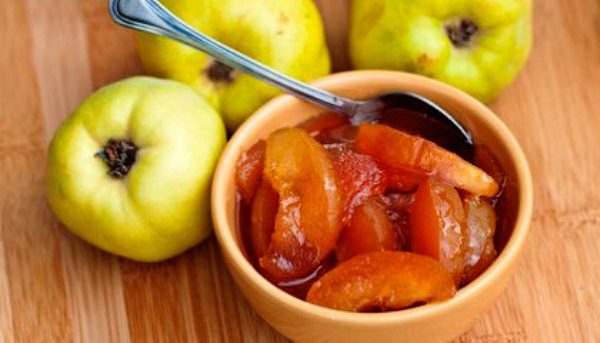
Antiemetic properties of quince help to cope with unpleasant manifestations of toxicosis. During pregnancy, various gastrointestinal dysfunctions are often noted, accompanied by flatulence.. In this case, will help the mashed potatoes of boiled fruit, which should be consumed 3 times a day for 3-4 tbsp. l
Quince is useful for preventing edema. Means according to popular recipes can be used to treat colds.Because many drugs during this period are contraindicated.
Every year the effectiveness of traditional methods of treatment is confirmed by scientific research. Partial replacement of chemical preparations with herbal remedies is attractive and relevant. If used correctly, quinces can be a good addition to the traditional treatment regimen., which reduces the aggressive effects of pharmacological drugs.
